 General
General  General Archive
General Archive  Blast From The Past: Borg, Navratilova, and the 1970s Cleveland Nets
Blast From The Past: Borg, Navratilova, and the 1970s Cleveland Nets
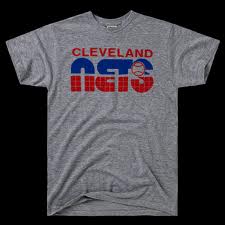 Here is a trivia question for you: You know about Ozzie Newsome, and all those Cleveland Browns players you heard about from your fathers and grandfathers. What do they have in common with tennis stars Martina Navratilova and Bjorn Borg? Answer: They are all sports Hall of Famers who represented Cleveland in their prime.
Here is a trivia question for you: You know about Ozzie Newsome, and all those Cleveland Browns players you heard about from your fathers and grandfathers. What do they have in common with tennis stars Martina Navratilova and Bjorn Borg? Answer: They are all sports Hall of Famers who represented Cleveland in their prime.
I polled some trusted friends and relatives on whether I could put together an interesting piece on the team for which these stars played, the Cleveland Nets. The responses I received included:
“Really?”
“That is kind of obscure, isn’t it?”
And my favorite response, cut and pasted directly from the email:
“This is about one notch below the Cleveland Crunch.” Ouch.
Sounds like a challenge.
As much as the next guy, I enjoy the process of unearthing isolated nuggets of information from multiple sources. It is a luxury to write about historical items that interest me, vs. beat reporting. I can avoid any subjects I want. For instance, I will never dwell on Ten Cent Beer Night, or Browns heartbreak (that is what the national media does its due diligence on when it comes to Cleveland, anyway). Penning stories from some tasty nuggets of info is highly satisfying. In fact, I occasionally feel sorry for the real sports writers on this site. It is amazing how they constantly come up with such great pieces, often based on watching the ‘same stuff, different year’.
Although compelling (to me), the stories I focus on may lean toward the obscure. It is true you won’t find massive essays on a Bob Feller or a Jim Brown in this corner. However, those history pieces are already written; you already Google them. Perhaps you start with Wikipedia. I do.
This seems like a great opportunity to give a quick nod to Swerb and Peeker, the purveyors of this website. That they back their writers with pretty much complete creative license remains a refreshing surprise to me. While this encourages writing that is free from corporate spin, it also helps the writer stay engaged with the writing process. I am like the beginning art student who doesn’t have to only paint vases and flowers. I can paint whatever I like. Sometimes the result is prettier than other times; this is part of the growth process. So I do my best to avoid being the liquored-up kicker and try my hardest to keep up with the all-star lineup here at tcf.
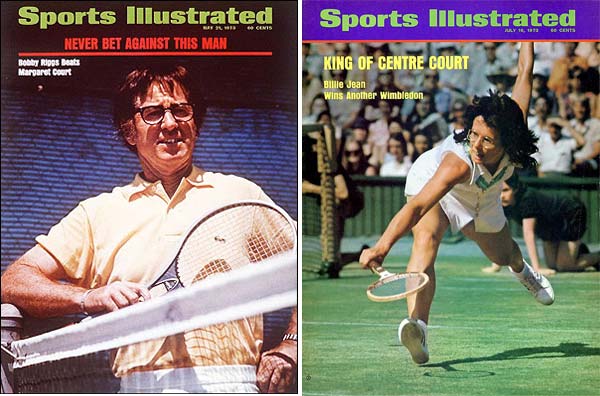 It could be said the Cleveland Nets were a result of a process, or a fad, that was set in motion by professional tennis player Bobby Riggs. Riggs was an American star whose career was at its apex in the 1940s. He was a noted hustler and gambler since his days as a teenager in southern California. Once he retired in the 1960s, Riggs was publicly encouraging bets on tennis and golf matches. He made a living on these matches, and they usually involved a gimmick such as employing a frying pan in place of a tennis racquet, or playing the entire round of golf while using only one golf club.
It could be said the Cleveland Nets were a result of a process, or a fad, that was set in motion by professional tennis player Bobby Riggs. Riggs was an American star whose career was at its apex in the 1940s. He was a noted hustler and gambler since his days as a teenager in southern California. Once he retired in the 1960s, Riggs was publicly encouraging bets on tennis and golf matches. He made a living on these matches, and they usually involved a gimmick such as employing a frying pan in place of a tennis racquet, or playing the entire round of golf while using only one golf club.
By 1973, the focus of the feminist movement was on gender equality. Sensing an opportunity to generate interest, Bobby Riggs began insisting that the women's tennis game was so inferior to the men's game that he was willing to bet that even at age 55, he could defeat any woman tennis player. He did proceed to defeat the top female player, 30 year old Margaret Court. Riggs had Court running up and back all day as he kept her off balance with a variety of shots. Before playing Court, he had challenged Billie Jean King, also a star. She accepted after the Riggs-Court match, and a purse of $100,000 was arranged.
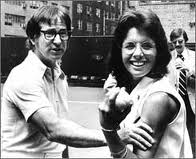
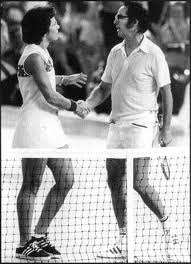 This was a hugely promoted match. Billed as the Battle of the Sexes, the match became highly anticipated; the network television coverage for the event became must-see TV (the bumper music for the telecast was “Anything You Can Do (I Can Do Better)”, from Annie Get Your Gun). Riggs, ever the showman, had hired an assistant who purportedly was some sort of nutritionist. The assistant supplied him with hundreds of tablets of vitamins a day. Riggs, a noted boozer, made a public show of taking all those pills for his health.
This was a hugely promoted match. Billed as the Battle of the Sexes, the match became highly anticipated; the network television coverage for the event became must-see TV (the bumper music for the telecast was “Anything You Can Do (I Can Do Better)”, from Annie Get Your Gun). Riggs, ever the showman, had hired an assistant who purportedly was some sort of nutritionist. The assistant supplied him with hundreds of tablets of vitamins a day. Riggs, a noted boozer, made a public show of taking all those pills for his health.
In Houston Astrodome in front of 30,000 fans and a vast television audience, King ran Riggs ragged. She had him running sideline to sideline, and he quickly wore down. Chalk one up for King, and for all of womanhood.
Interest in tennis was reaching an all-time high. Also during this 1970s era, the United States boasted a fine crop of top men and women tennis players. Well established Americans included Chris Evert, Jimmy Connors, Arthur Ashe and John McEnroe
Against this backdrop, enter Jordan Kaiser, Dennis Murphy and Larry King (Billie Jean’s husband). They spearheaded a new tennis league that would capitalize on the sport’s popularity. This caused controversy with the traditional tennis world. The old guard frowned at the colorful, no-line courts and the encouragement of loud cheering and the heckling of opposing players by fans in attendance (the heckling was said to be particularly bad in Baltimore and Philadelphia, where they would yell “MISS IT!” prior to the opponent returning a shot).
World Team Tennis began operations as the first co-ed professional sports team, with Riggs-King as a backdrop. League play began in 1974 with 16 teams. Each team consisted of three men and three women. The initial rules of play resulted in long, drawn-out 4-hour ‘games’; the league soon pared down matches to include one set each for men’s and women’s singles, one set each for men’s and women’s doubles, and one mixed doubles set. And instead of the standard 15-30-40 tennis scoring, a score was awarded one point each, with no ad-ins or ad-outs. The intent was to appeal to the casual sports fan. Current LA Lakers/LA Kings owner Jerry Buss and New England Patriots owner Robert Kraft were original WTT owners.
Joe Zingale, a Cleveland radio executive, bought a franchise in the new league for $50,000. It was to play at Cleveland’s Public Hall. A charter member of the WTT, the Cleveland Nets acquired native Clevelander Clark Graebner and installed him as player-coach. Graebner was apparently a chauvinist of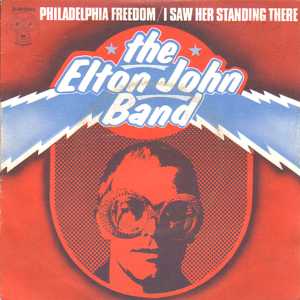 some measure; for example, on one occasion he blamed a loss to the Denver Racquets on three of his players’ menstrual periods. However, one of my favorite sports anecdotes of all time was supplied by Graebner. When he originally was drafted by the Nets, he insisted that his wife Carol be drafted as well. She was. Soon after, however, the Graebners divorced. Clark Graebner proceeded to trade Carol, to Pittsburgh! Too funny.
some measure; for example, on one occasion he blamed a loss to the Denver Racquets on three of his players’ menstrual periods. However, one of my favorite sports anecdotes of all time was supplied by Graebner. When he originally was drafted by the Nets, he insisted that his wife Carol be drafted as well. She was. Soon after, however, the Graebners divorced. Clark Graebner proceeded to trade Carol, to Pittsburgh! Too funny.
The 1974 Cleveland Nets ended the year at 21-23. The team navigated rough waters when noted doubles player “Peaches” Bartkowicz (love the name) quit. (It was a dilemma when a player quit or became injured. It was difficult to find capable replacements; the WTT season coincided with the European clay court tournament season.) The Nets faced the Philadelphia Freedom in the first round of the playoffs, and got summarily bounced. This was the team led by Billie Jean King. Elton John had become good friends with her, and came out with a popular song in the team’s honor. (By the way, Elton John’s first US concert had been at Cleveland’s Public Hall, in 1972. Also, I happen to own the 45rpm record of Philadelphia Freedom- the flip side would appear promising: it is a live version of I Saw Her Standing There, with John Lennon. The backing horns are Muscle Shoals, mentioned in Lynyrd Skynyrd's Sweet Home Alabama. Alas, the version of the Beatles song on the record is not very good.)
 By 1975, the Richfield Coliseum was in operation, and became the home for the Cleveland Nets (as well as for the Cavaliers and the hockey Crusaders; Zingale was also a minority owner of the Cavs). The new, big-name player-coach was Marty Riessen. Attendance averaged about 1000/game. Clark Graebner was retained as a player; Riessen (the no. 3
By 1975, the Richfield Coliseum was in operation, and became the home for the Cleveland Nets (as well as for the Cavaliers and the hockey Crusaders; Zingale was also a minority owner of the Cavs). The new, big-name player-coach was Marty Riessen. Attendance averaged about 1000/game. Clark Graebner was retained as a player; Riessen (the no. 3 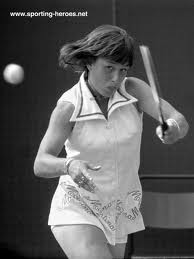 US men's player) and Graebner were top doubles players at the time. Riessen was the 1975 men’s Rookie of the Year.
US men's player) and Graebner were top doubles players at the time. Riessen was the 1975 men’s Rookie of the Year.
1976 was the year Zingale lured the promising young Martina Navratilova to the Nets for a season. He gave her a huge diamond pendant in the shape of a #1, along with a $150,000 contract. This created a huge amount of attention; Navratilova had just defected to the US from Czechoslovakia the year prior. She began to become renowned as one of the best singles players and the very best doubles player in the world. Unfortunately, the team’s fortunes did not improve although attendance did somewhat.
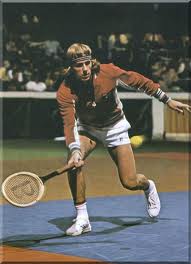 When WTT started out in 1974, top women players were more likely to sign than top men. The mercurial Ilie Nastase (Google that name for some stories) was the first male with star power to sign with the league, in 1975. For the 1977 season, the Cleveland Nets were able to sign Bjorn Borg and his fiancée, Romanian Mariana Simionescu (photographers loved her. She can be seen in the team photo on left; Borg and Simionescu are facing each other) . A tennis superstar who was at the top of his game, Borg already had a tennis Grand Slam on his resume. WTT had wanted him in the league since 1974. In the years since, he battled Jimmy Connors and Guillermo Vilas for the top men’s tennis ranking. In 1977, Vilas wore that mantle, by default, since both Borg and Connors had WTT commitments. Borg’s involvement in with the Nets caused French Open officials to declare him ineligible; he would not be allowed to try for his third straight title. Borg has expressed some regret over this, although the 1977 season played out nicely for him: he was the men’s Rookie of the Year and the men’s All Star Game Most Valuable Player. Oh, and he also took home a paycheck for $300,000 for playing the sixteen week season.
When WTT started out in 1974, top women players were more likely to sign than top men. The mercurial Ilie Nastase (Google that name for some stories) was the first male with star power to sign with the league, in 1975. For the 1977 season, the Cleveland Nets were able to sign Bjorn Borg and his fiancée, Romanian Mariana Simionescu (photographers loved her. She can be seen in the team photo on left; Borg and Simionescu are facing each other) . A tennis superstar who was at the top of his game, Borg already had a tennis Grand Slam on his resume. WTT had wanted him in the league since 1974. In the years since, he battled Jimmy Connors and Guillermo Vilas for the top men’s tennis ranking. In 1977, Vilas wore that mantle, by default, since both Borg and Connors had WTT commitments. Borg’s involvement in with the Nets caused French Open officials to declare him ineligible; he would not be allowed to try for his third straight title. Borg has expressed some regret over this, although the 1977 season played out nicely for him: he was the men’s Rookie of the Year and the men’s All Star Game Most Valuable Player. Oh, and he also took home a paycheck for $300,000 for playing the sixteen week season.
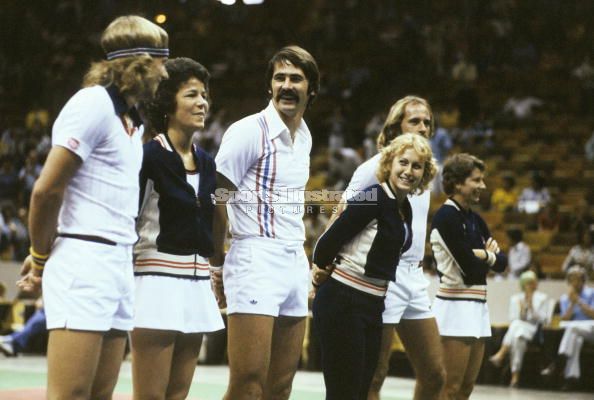 So the 1977 season generated some extra attention- but the attendance at the Coliseum was not sufficient to sustain the franchise. In fact, Joe Zingale had begun holding some ‘home’ matches in cities like New Orleans, Nashville, Miami and Pittsburgh (the latter’s original franchise had gone belly up). The Nets began to be called the ‘Cleveland-Pittsburgh Nets’. The match held in New Orleans had drawn well, so Zingale moved the team there prior to the 1978 season. Unfortunately, the league folded that year. The WTT brand was resurrected in 1981, playing in much smaller venues and featuring less marquee players. The league continues to this day. (To the right is a modern-day WTT court; the Borg photo above it provides a hint as to how the 1970s vintage court appeared, sans lines.)
So the 1977 season generated some extra attention- but the attendance at the Coliseum was not sufficient to sustain the franchise. In fact, Joe Zingale had begun holding some ‘home’ matches in cities like New Orleans, Nashville, Miami and Pittsburgh (the latter’s original franchise had gone belly up). The Nets began to be called the ‘Cleveland-Pittsburgh Nets’. The match held in New Orleans had drawn well, so Zingale moved the team there prior to the 1978 season. Unfortunately, the league folded that year. The WTT brand was resurrected in 1981, playing in much smaller venues and featuring less marquee players. The league continues to this day. (To the right is a modern-day WTT court; the Borg photo above it provides a hint as to how the 1970s vintage court appeared, sans lines.)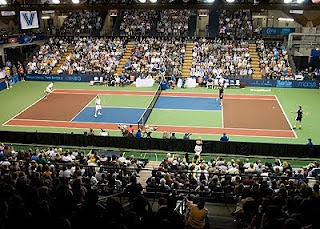
Martina Navratilova and Bjorn Borg emerged from their Cleveland Nets experience to continue their assault on all-time records in the sport of tennis. Cleveland may only be a footnote in their history (although Navratilova has returned recently for an exhibition fundraiser). LIkewise, they are but a footnote in our sports history as well. But the fact remains: they are Hall of Famers who played for Cleveland in their prime.
Thank you for reading.
Below: 1977 WTT Official Magazine, featuring the face of the league, Billie Jean King.
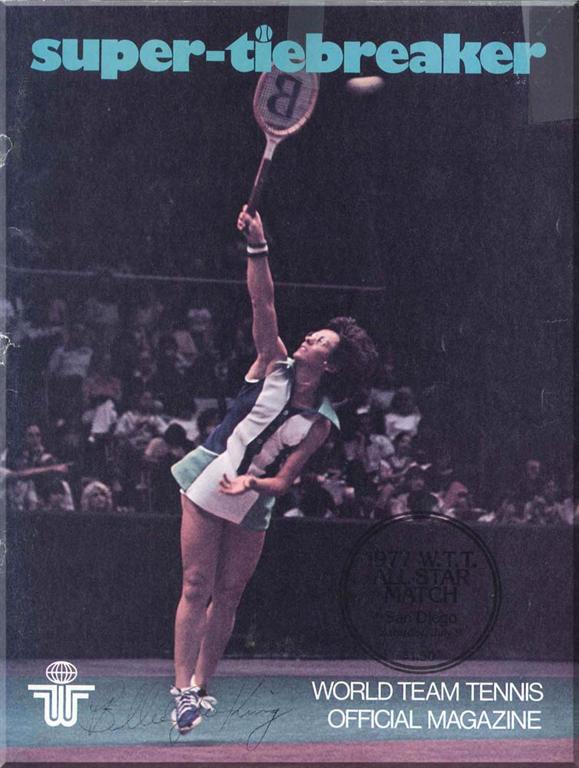
- NBA Announces 2013-2014 Schedule
- Browns Ink Sharknado
- Sharknado A No-Show For Rookie Camp
- Trent Richardson Out Until Training Camp
- Browns Sign Brandon Jackson
- Carrasco Suspended Eight Games
- Browns Add to Wide Receiver Depth with David Nelson
- Browns Need to Learn from Past Draft Mistakes
- Browns Release Chris Gocong and Usama Young
- Browns Missing on Grimes Disappointing, But Not The End
The TCF Forums
- Official- Browns Coach Search/Rumors
mattvan1 (Tuesday, January 21 2014 1:19 PM) - Movies coming out
rebelwithoutaclue (Tuesday, January 21 2014 12:56 PM) - 2015 Recruiting
jclvd_23 (Tuesday, January 21 2014 12:38 PM) - The 2014 Offseason Thread
Larvell Blanks (Tuesday, January 21 2014 12:25 PM) - Chris Grant's first 3 drafts
Kingpin74 (Tuesday, January 21 2014 10:13 AM) - Mike Brown
YahooFanChicago (Monday, January 20 2014 11:15 PM) - 2014 Hoops Hockey Hijinx
jpd1224 (Monday, January 20 2014 4:44 PM) - 2014 Recruiting
jclvd_23 (Monday, January 20 2014 2:26 PM) - Wish List - #4 Pick
Hikohadon (Monday, January 20 2014 1:26 PM) - #1 overall pick Anthony Bennett
TouchEmAllTime (Sunday, January 19 2014 1:28 PM)



